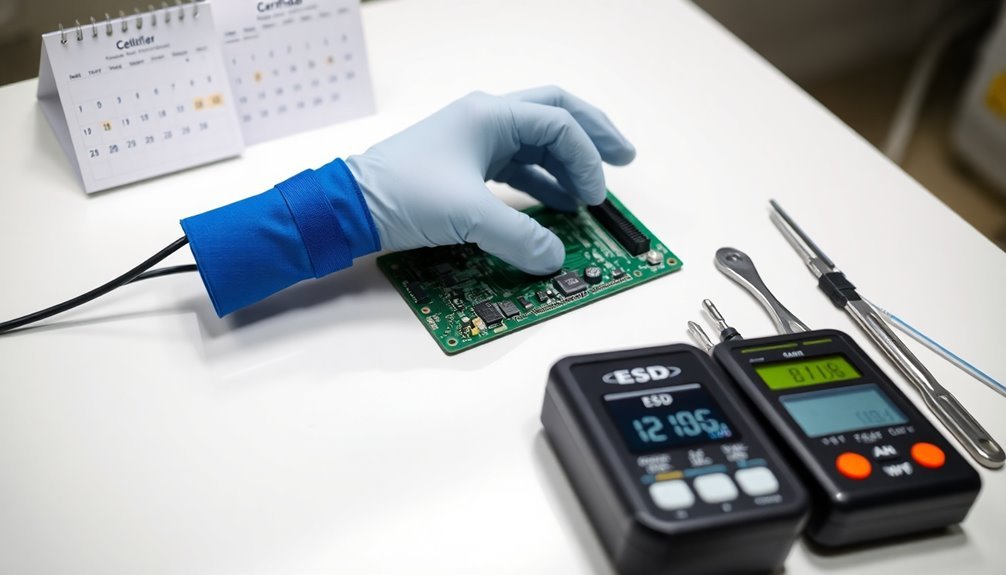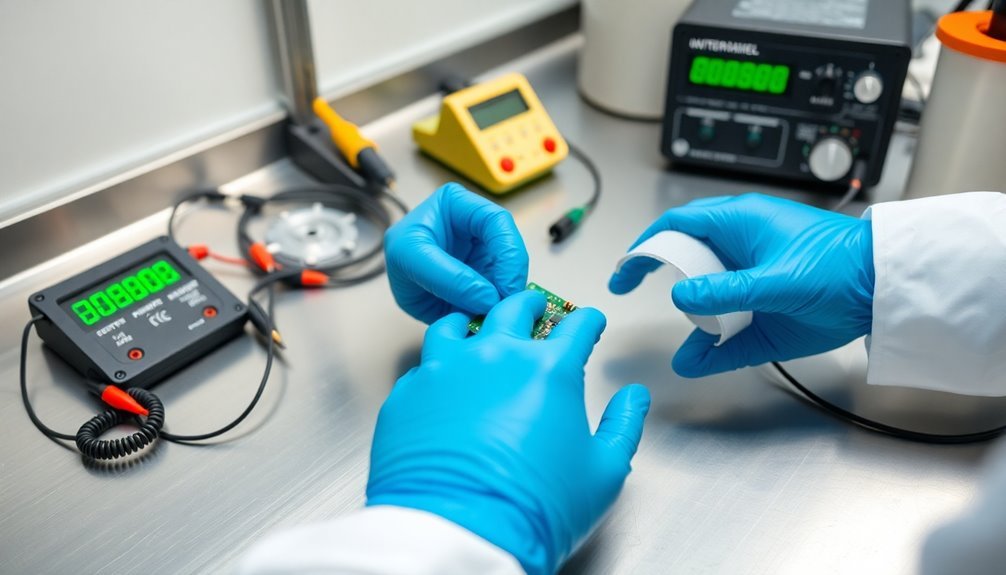To renew your anti-static certification, you'll need to follow five essential steps. Start by checking your renewal timeline, as notifications typically arrive 90, 60, and 30 days before expiration. Next, compile your professional development hours from approved industry events and workshops. Complete the required ethics training, which includes at least 5 hours of relevant coursework. Then, submit your renewal documentation, including forms, photos, and training certificates, at least 60 days before expiration. Finally, process your payment through the secure online system. Understanding these steps in detail will guarantee a smooth certification renewal process.
Check Your Renewal Timeline

Don't rely solely on the reminder system. While AMPP sends email notifications at 90, 60, and 30 days before expiration, it's your responsibility to track your timeline and maintain current contact information.
Even if you don't receive these notices, you're still accountable for completing the renewal process on time.
Watch your email for renewal instructions directing you to the My Certification Portal, where you'll submit your application and payment online.
Submit your application at least 45 days before your current certification expires to ensure your certification status remains active without interruption.
Compile Professional Development Hours
Once you've confirmed your renewal timeline, gathering your Professional Development Hours (PDHs) becomes your next major task.
You'll need to carefully track and document your professional development activities to meet certification requirements. Industry conferences and specialized workshops serve as primary sources for earning PDH credits, but you'll need to verify that these events are pre-approved by your certifying body. A maximum of 12 credits can be earned from any single training event or activity.
Keep detailed records of your PDH activities, including attendance certificates and registration documentation.
When converting Continuing Education Units (CEUs) to PDHs, use the standard ratio of 1 CEU to 10 PDHs. Remember to check your state's specific requirements, as acceptance criteria can vary by jurisdiction.
- Create a spreadsheet to track your PDH credits, including dates, event names, and credit hours earned
- Store digital copies of all certificates, rosters, and verification documents in a dedicated folder
- Cross-reference your accumulated PDHs against your certification's requirements to guarantee compliance
Complete Ethics Training Requirements

In accordance with certification standards, completing ethics training represents a fundamental requirement for maintaining your Anti-Static certification. You'll need to complete at least five hours (0.5 points) of ethics courses during your recertification cycle, starting July 1, 2023. Make sure you retain all certificates of completion, as you may need to provide these during an audit.
| Training Component | Requirement |
|---|---|
| Minimum Hours | 5 hours |
| Points Value | 0.5 points |
| Passing Score | 80% minimum |
| Documentation | Completion certificate |
Ethics training enhances your professional integrity and decision-making capabilities while guaranteeing compliance with industry standards. Human resources departments often provide convenient access to approved ethics training programs. You can access ethics courses through various approved providers, including BCSP's certification programs and other recognized institutions. These courses typically include interactive modules, quizzes, and practical scenarios that address real-world ethical challenges.
When selecting your ethics training, verify it meets certification requirements and covers relevant content for anti-static professionals. You'll need to demonstrate understanding through assessments and maintain records of your completed coursework. Remember that ethics training isn't just about meeting requirements—it's about building trust and maintaining high professional standards in your field.
Submit Required Documentation
Building on your completed ethics training, proper documentation submission forms a key part of your Anti-Static certification renewal process. You'll need to submit your renewal materials at least 60 days before your certification expires to facilitate timely processing. IAPMO will process your documentation and you'll receive your updated wallet card within 3-4 weeks.
Make sure you've gathered all necessary documents, including your completed renewal request form, renewal fee payment, current photos, and any applicable declination forms.
For your documentation package to be complete, you'll need to demonstrate your continuing education activities from the past three years. Include 1.5 CEUs per certification along with supporting evidence of your professional development activities. All documents must be accurately dated within the required timeframe to be considered valid.
- Include training certificates, professional activity records, and completed application forms
- Submit current AHERA certificates and any additional required certifications
- Provide proof of certification-specific continuing education hours
Remember that you won't receive a grace period for late submissions, and letting your certification expire will result in reapplication and additional fees. If you need clarification about specific documentation requirements, contact certifications@iapmo.org for guidance.
Process Payment and Verify

After gathering your documentation, you'll need to process the renewal payment through the secure online system. The system will guide you through entering your payment information and applying any available discounts if you're an active member.
Once you've submitted the payment, you'll receive an immediate confirmation and receipt for your records.
The annual maintenance fee of $25 is required to keep your certification active and compliant with industry standards.
The certification organization will process your renewal application within 2-3 business days after receiving your payment and documentation. Your certification status will automatically update in the system once everything's approved.
Keep in mind that you can start this renewal process up to 90 days before your certification expires.
If you miss your renewal deadline, you'll have a 90-day grace period to complete the process, though late fees may apply. Don't let your certification lapse beyond this period, as you might face reinstatement fees or certification suspension.
After successful payment and verification, you'll maintain your active certification status and continue receiving program benefits, including updates and notifications.
If you need replacement credentials like wall certificates or wallet cards, you can request them for an additional fee.
Frequently Asked Questions
What Happens if I Lose My Certification Number During the Renewal Process?
If you've lost your certification number, you can contact your certification body's support team. They'll verify your identity and provide your number. Don't worry – this won't affect your renewal process.
Can I Transfer My PDH Credits to Another Certification Program?
Yes, you can transfer your PDH credits to other certification programs. Be sure to verify the transfer limits and requirements with your specific board, as rules vary between states and programs.
Is the Ethics Requirement Waived if I Completed Training Elsewhere?
No, your ethics requirement isn't automatically waived. While you can submit equivalent training for approval, it must meet AMPP's standards. You'll need to provide proof of completion through the certification portal for consideration.
Are Group Renewal Discounts Available for Companies With Multiple Certified Professionals?
Yes, you'll find group renewal discounts available for certain certification programs when multiple professionals apply together. However, based on the provided information, group discounts aren't specifically mentioned for anti-static certification renewals.
How Do I Update My Contact Information if It Changed During Certification?
You'll need to log into your certification provider's online portal to update your contact details. You can also notify them by phone or email, and always verify that they've processed your changes.
In Summary
You're now equipped to renew your anti-static certification efficiently. Don't wait until the last minute to check deadlines, gather PDH documentation, or complete your ethics training. By staying organized and following these five steps, you'll maintain your professional credentials without disruption. Once you've submitted your paperwork and payment, you can continue your work with confidence, knowing your certification is current.





Leave a Reply